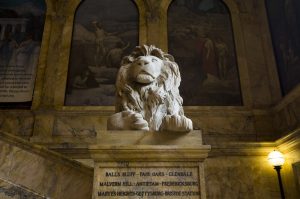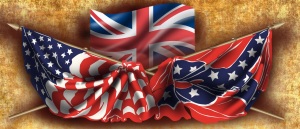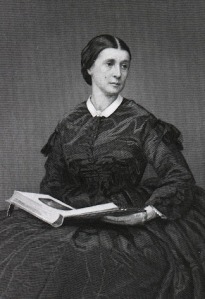Ancestry ∗ Biography ∗ History
In 1861, while Henry was on active duty in the war in Virginia, a different war effort was being played out 3,000 miles across the Atlantic Ocean in England involving Henry’s cousin, the Rev. Francis William Tremlett.
Confederate President Jefferson Davis knew that the industrial North would have an advantage of men and materials over the largely agrarian South. To offset this advantage he decided to seek an alliance with the Europeans, and he therefore dispatched envoys to Britain and France months before Sumter. Davis wasn’t doing anything that the American colonies hadn’t done during the American Revolution when they dispatched Benjamin Franklin to France; Davis wanted an alliance, preferably with England. Unfortunately, in the beginning the Confederacy lacked statesmen who were experienced in foreign affairs, and initial overtures to London were largely unsuccessful. The Union also had an advantage by already having an established diplomatic delegation with both European governments. The Union also certainly augmented its “foreign service” as well.
It wasn’t until May that James D. Bulloch, a newly appointed commander in the Confederate navy, was sent by the Confederate government to London with the same mandate: to secure an alliance with England and arrange for the acquisition of various types of warships and other military equipment. Bulloch would become the principal Confederate naval agent in Europe. His orders were as follows:
[SECRET]
An act authorizing an agent to be sent abroad to purchase vessels and arms, and making an appropriation therefore.
The Congress of the Confederate States of America do enact, That to enable the Navy Department to send an agent abroad to purchase six steam propellers, in addition to those heretofore authorized, together with rifled cannon, small arms, and other ordnance stores and munitions of war, the sum of one million of dollars is hereby appropriated out of the Treasury of the Confederate States.
Howell Cobb
President of the Congress.
Approved, May 10, 1861.
Jefferson Davis.
A true copy.
James M. Matthews,
Law Clerk, Department Justice.[1]
Soon after arriving in England, Bulloch entered agreements at Liverpool, first with English shipbuilders William C. Miller & Sons, and shortly thereafter with Fawcett, Preston & Company, to build the first of several ships designed as commerce raiders in June 1861.[2] From opening negotiations to delivery, the process was a difficult and risky business. Union spies were conspicuously everywhere. Further, Confederate efforts to procure ships of war were hampered by British legalities.
The official position of the British government was abolitionist and militarily neutral with regard to the American Civil War. The Slavery Abolition Act of 1833 had outlawed slavery throughout the United Kingdom, with a few territorial exceptions that would be included by 1843.[3] British neutrality and maritime law were governed by an eclectic collection of archaic laws, agreements, and policies.
Foremost among these laws was the British Foreign Enlistment Act of 1819, which included salient provisions with respect to Britain and its involvement in any foreign war. British subjects were prohibited from enlisting in the armed forces of a foreign country or engaging in any activity capable of drawing Britain into a war. The first part was straightforward enough. If you were a British subject, you were prohibited from joining the military at a time of war with any nation with which Britain was at peace. The second part, that prohibited “any activity capable of drawing Britain into a war” was a bit more ambiguous and therefore subject to interpretation.
The Foreign Enlistment Act also stated that any contract for the construction of naval vessels in British shipyards for either North or South could not include equipment or fitting them out for war while the vessel was in England. It would seem that this provision would present obstacles for the Confederacy, and it did, but as we shall see, the law was difficult to enforce and not impossible to circumvent because of the phrase “while the vessel was in England”. In the early years of the war, Bulloch and other Confederate agents recognized and exploited this loophole by having British-built ships weaponized in clandestine ports.
There was also the Treaty of Paris of 1856. Besides ending the Crimean War, the treaty included provisions that prohibited the seizure of a belligerent’s goods by its enemy from a ship flying a neutral flag unless the goods were contraband. Presumably this was the legal means by which, for example, a British ship could conduct trade with both North and South, so long as the ship was flying a British flag with no illicit goods on board. However, what was the definition of contraband and how could one prove the existence of contraband on a ship on the high seas unless one had the necessary knowledge beforehand?
The Treaty of Paris also stated that blockades had to be effective to be honored by a neutral government such as Britain; otherwise, free trade should be permitted. This was an issue in the beginning of the war in which the Union blockade’s effectiveness was questioned: how could the Union Navy effectively blockade the entire American coast from Maryland to Texas? Eventually the U. S. Navy did choke off trade with the Confederacy sufficiently, which removed any doubt or criticism about the effectiveness of the U.S. blockade.
Finally, The Treaty of Paris also prohibited any signatory government from enabling privateering, specifically by a letter of marque, which was a government license authorizing a private individual known as a privateer to attack and capture enemy vessels. Privateering was nothing more than piracy with a government’s sanction, but a neutral country that sanctioned privateering definitely risked committing an act of war.
Despite the laws, a real fear existed in British minds in 1860 that an “accident” at sea might obligate Britain to intercede on one side of the American war or the other. This resulted in Queen Victoria’s Proclamation of Neutrality in 1861, which was meant to augment and strengthen the generalized provisions of the Foreign Enlistment Act and the Treaty of Paris by lending specificity to the law in regard to the United Kingdom’s involvement in the Civil War. Provisions of the proclamation stated unequivocally that Great Britain was officially neutral with regard to the war but also provided for recognition of the Confederate States of America as a belligerent in the war. Belligerent status enabled Confederate ships to obtain fuel, supplies, and repairs in neutral ports but prohibited them from securing munitions or other military equipment. Recognition as a belligerent did not mean the same thing, however, as recognition of the Confederate States of America as a sovereign nation separate from the United States of America.
However Bulloch was undeterred in his task, and he and the English shipbuilders were very crafty about dealing with these obstacles. When construction of a ship began, the builders would identify the ship oftentimes simply by a number. Ships wouldn’t typically be christened or commissioned before construction was completed. When a ship was given a name, it would frequently be a false name, or the ship might be misrepresented as being deliverable to a paper purchaser. An example of this was the Oreto, which was represented as being intended for delivery to Italy but was really destined to be the first British-built seagoing Confederate commerce raider, CSS Florida.
As for the Foreign Enlistment Act, Bulloch had shrewdly arranged for the Oreto to be built without being fitted out for cannon, munitions or any other equipment for war. Still, word of Bulloch from suspicious Union agents reached U.S. Ambassador Charles Francis Adams, who immediately relayed the information to Lord Russell. As a result, the Oreto was inspected and searched, but no violations were found. By now Bulloch was residing in one of the Reverend Tremlett’s safe houses.
Shortly after the Oreto agreement, Bulloch entered another one, this time with John Laird Sons & Company. In August 1861, the keel was laid for a ship that bore only the number 290, so named because she was the 290th hull to be constructed in the Laird yard at Birkenhead opposite Liverpool on the Mersey River. She would eventually come to be known as the CSS Alabama, certainly the most famous and successful commerce raider of her day, and possibly the greatest of all time. The image at the top of the post is a painting of the Alabama in the Mersey River, Liverpool, prior to sea trials. It’s one of many glorious maritime paintings by the remarkably talented British painter E. D. Walker.
The two ships, Oreto and 290, were being constructed virtually simultaneously in separate shipyards belonging to separate builders but in relatively close physical proximity to each other. So much activity couldn’t help but attract the attention of the Union’s consul in Liverpool, Thomas H. Dudley, who had a splendid view of the construction from his office. Dudley contacted his government and dispatched spies to the yards in order to learn what they could, but nothing of use was discovered. Dudley relegated the issue to a lower priority, at least for the time being, since the ships wouldn’t be completed for some time.
If there had been any questions that Britain would endeavor to enforce maritime law, despite all of the implied difficulties, the Trent Affair dispelled them. In October 1861, the Confederate government planned to send two new envoys to England with the mandate of pressing the Confederate case for British support. Unbeknownst to the Confederates, the plan fell into Union hands, and as a result, the Union sent the steam frigate USS San Jacinto to Havana, where the envoys were waiting to make passage to England on a British ship.
On November 7, 1861, while Henry and the Twentieth Massachusetts were licking their wounds after Ball’s Bluff, the British mail packet RMS Trent embarked with the two envoys, James M. Mason and John Slidell, on board bound first for the island of St. Thomas. The Union captain of the San Jacinto, Charles Wilkes, was familiar with international maritime law, including Queen Victoria’s Proclamation of Neutrality, but concluded on his own initiative that the envoys themselves constituted contraband.
Wilkes encountered the Trent, which was flying the Union Jack, around noon on November 8, and fired two shots across her bow before the Trent would heave-to. He boarded her and transferred the Confederate envoys by force of arms to the San Jacinto, which sailed back to Hampton Roads, Virginia, where news of the capture was wired to Washington. Wilkes was next ordered to sail for Boston, where he was further instructed to turn over the captives at Fort Warren, which had been converted to a prisoner-of-war camp in Boston Harbor.
As one might expect, the North reacted with elation, and everyone there was eager to provide legal justification for the capture, but not so in the Confederacy or, more importantly, Great Britain. The British Foreign Office requested a judicial opinion from the three law officers of the Crown (the queen’s advocate, the attorney general, and the solicitor general) on the legality of capturing foreign diplomats from a British ship. The reply was as follows:
The United States’ ship of war may put a prize-crew on board the West India steamer, and carry her off to a port of the United States for adjudication by a Prize Court there; but she would have no right to move Messrs. Mason and Slidell, and carry them off as prisoners, leaving the ship to pursue her voyage.[4]
Lord Palmerston was as mad as a wet hornet. He’d been assured by U.S. Ambassador Adams that the United States would not interfere with British vessels. The Trent Affair would now require a response from the British government in order to defend that nation’s interests and demonstrate some bite in British maritime law, so Palmerston engaged the law officers again. The response was that Captain Wilkes’ actions were found to be illegal and unjustifiable by international law.
Palmerston and other British officials began to worry that if the United States snubbed British maritime law, what was next… a U.S. invasion of Canada? This was no joke. Some were concerned that “United States’ manifest destiny” would result in the United States eventually becoming comprised of all North, South, and Central America. Diplomatic relations became strained. Britain sent 10,000 troops to Canada.
Fortunately cooler heads and the established bonds of diplomacy between Britain and the United States would eventually prevail. Neither country wanted war with the other, and the issue was quickly diffused in January 1862. The United States moderated its stance, saying that Captain Wilkes had been overzealous in the execution of his duties. The Confederate diplomats were released from Fort Warren, boarded HMS Rinaldo at Provincetown, and eventually sailed for England.
[1] United States Naval War Records Office, Official Records of the Union and Confederate Navies in the War of the Rebellion, series II, vol. 2, Navy Department Correspondence 1861–1865, with Agents Abroad (Washington, D.C.: Government Printing Office, , 1921), 66; courtesy of Cornell University Library, Making of America Digital Collection.
[2] Bennett, John D. The London Confederates: The Officials, Clergy, Businessmen and Journalists Who Backed the South in the Civil War. Jefferson, NC: McFarland, 2008; p. 63.
[3] http://en.wikipedia.org/wiki/Slavery_Abolition_Act_1833, accessed December 3, 2015.
[4] Baxter, James P. III, “Papers Relating to Belligerent and Neutral Rights, 1861–1865,” American Historical Review 34, no. 1 (1928): Pp. 84–86.
Next: Ships and Skulduggery
Find out more about Colonel Henry Martyn Tremlett and his cousin, the Rev. Dr. Francis William Tremlett during the American Civil War in my book, The Colonel and the Vicar, available on Amazon.com.











